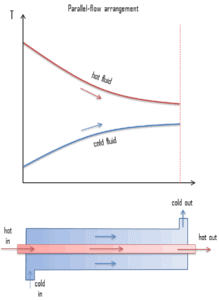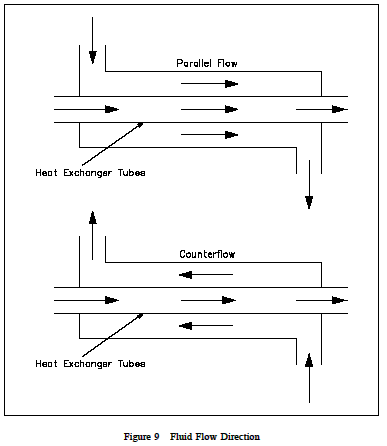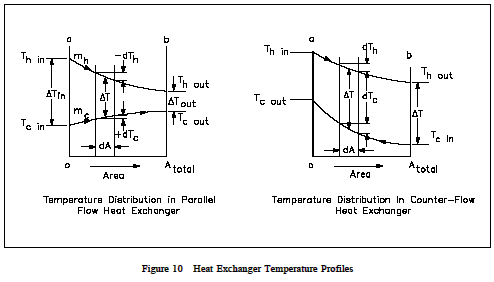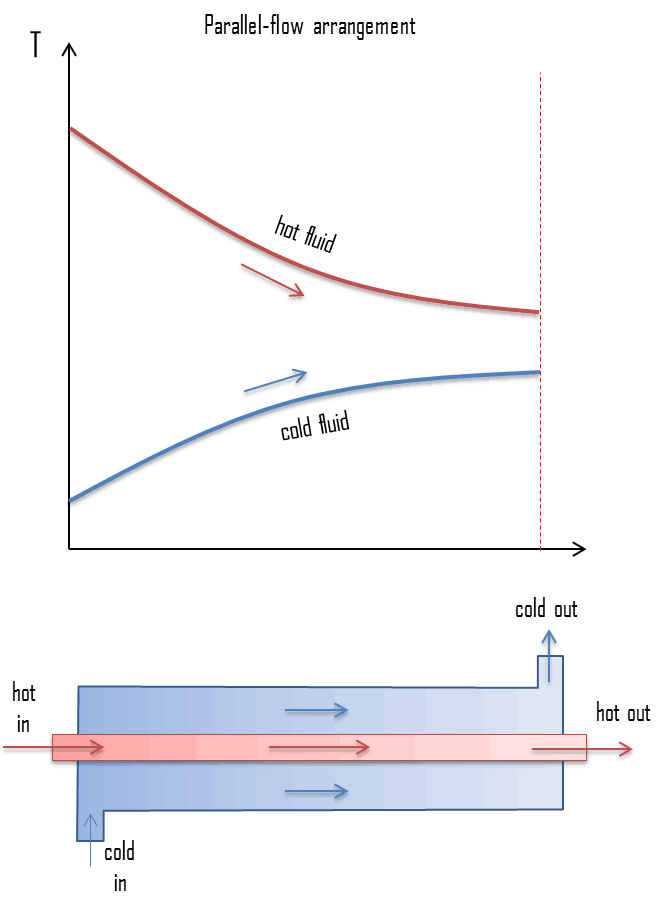Identify the Characteristics of Parallel Flow Heat Exchangers.
The mal-distribution becomes more severe with the rising velocity at the intake conduit. The three categories are parallel flow counter flow and cross flow.

What Is Parallel Flow And Counter Flow Heat Exchanger Definition
When is the arithmetic mean temperature difference of heat exchanger used instead of LMTD.

. Parallel Flow Heat Exchangers Parallel Flow Heat Exchangers In general parallel flow heat exchangers considered less efficient than counter flow heat exchangers in terms of transferring heat from one fluid to another. Flow distribution is improved via. Refrigerant-124 was used as the experimental fluid.
It is the most efficient among the three exchangers. Question 2 of 17 value. The results demonstrate that given the same operating conditions operating the same heat exchanger in a counter flow manner will result in a greater heat transfer rate than operating in parallel flow.
Check all that apply The hot and cold fluids move in the opposite direction. The hottest steam and the coldest water enter the exchanger at one end and the cooled steam and the heated water exit at the other end. The answer below gives an application of parallel flow heat exchangers.
The counter-flow heat exchanger has three significant advantages over the parallel flow design. In a parallel heat exchanger the hot water and the steam flow in the same direction. In actuality most large heat exchangers are not purely parallel flow counter flow or cross flow.
Baffles force the shell-side fluid to flow across the shell to enhance the heat transfer. Within this group are for example surface exchangers and mixing exchangers. This means that while the heat differential is never as large as it is at the beginning of parallel flow system over the course of cooling it stays large resulting in total heat exchange much greater than a parallel model - with a theoretical maximum coolingheating of 100 of the differential in an infinitely long system.
Parallel flow counterflow cross-flow single pass and multi-pass heat. Of hot fluid are. This flow arrangement is called parallel flow.
Flow mal-distribution in heat exchangers may be spatial temporal or both its effect being to reduce both thermal and fluid dynamic performances. The arithmetic mean temperature difference for parallel flow heat exchanger is given as a. Either way the transmission of thermal energy occurs without the need for fluids to be joined.
Adjusted mass flow rate of hot fluid m h are recorded. In a counter flow heat exchanger the two media are flowing in opposite directions. The hottest steam enters on the left side.
Highlights The flow distribution into parallel flow heat exchangers with rectangular headers is examined. However there are applications where parallel flow has its benefits such as when limiting the transfer of heat is recommended. The main characteristics by which heat exchangers can be categorized include.
250 TOP MCQs on Heat Exchangers and Answers. 250 TOP MCQs on Double Pipe Heat Exchangers Heat Transfer. First the more uniform temperature difference between the two fluids minimizes the thermal stresses throughout the exchanger.
ΔT am ΔT i ΔT e b. What are the benefits of the baffles in a shell-and-tube heat exchanger. Heat is transferred from the warm fluid through the wall of the inner tube the so-called heating surface to the cold fluid.
250 TOP MCQs on Heat Transfer Applications Plate Heat Exchangers and Answers. The fluid enters through the same end in a parallel flow heat exchanger and travels adjacent to each other in a parallel manner in the same direction while in the counter flow heat exchanger two fluids move in opposite direction to each other. Do a weighted average of the U-values If youve got three pathways youd add another term to the numerator with U3 x A3.
Because heat exchangers come in so many shapes sizes makes and models they are categorized according to common characteristics. The experimental study was conducted for a wide variety of flow parameters. Parallel flow heat exchangers are also used in some cases when both the hot and cold fluid need to brought to the same temperature approximately as it lowest temperature of the hot fluid will still be higher than the highest temperature of the cold fluid in parallel flow.
You can add as many terms as you need to include all the parallel pathways. Identify the characteristics of parallel flow heat exchangers. An experimental setup was built to study the characteristics of micro-channel heat exchangers.
The hot and cold fluids enter the heat exchanger at opposite ends The hot and cold fluids enter the heat exchanger at the same end. The first several tubes may show only 50 flow rate of the last tube. 300 points 11-1C b Identify the characteristics of counter flow heat exchangers.
Another criterion for classifying heat exchanger types is the relative orientation of the fluids. The mal-distribution is mainly associated with the jet flow pattern. One common characteristic that can be used to categorize them is the direction of flow the two fluids have relative to each other.
Of hot fluid are recorded T h1 The Outlet temp. Parallel flow and counter flow heat exchanger experiment. As a first step single-phase tests were conducted on a parallel-channel micro-heat-exchanger.
Many papers have dealt with the effects of flow mal-distribution on the performance of heat exchangers Mueller 1987 Mueller and Chiou 1988 Probhakara Rao et al 2005. ΔT am ΔT i ΔT e 2 View Answer Hide Answer 4. ΔT am ΔT i ΔT e c.
250 TOP MCQs on Heat Exchanger Effectiveness and Answers. Similarly a shell and tube heat exchanger can be operated in approximately parallel flow by having both fluids enter at one end and exit at the other end. Second the outlet temperature of the cold fluid can approach the highest temperature of the hot fluid the inlet temperature.
Parallel Heat Flow. After youve got your average U-value you can then take the reciprocal 1Uavg to find the average R-value. Adjusted mass flow rate of cold fluid m c are recorded.
Flow configuration Construction method Heat transfer mechanism Flow Configuration The flow configuration also referred to as the flow arrangement of a heat exchanger refers to the direction of movement of the fluids within the heat exchanger in relation to each other. For parallel flow heat exchangers both the hot and cold fluids enter at the same end and move in the same direction. They are usually a combination of the two or all three types of heat exchangers.
A heat exchanger can also be operated in counterflow in which the two fluids flow in parallel but opposite directions. With parallel flow the temperature difference between the two fluids is large at the entrance end but it becomes small at the exit end as the two fluid temperatures approach each other. ΔT am ΔT i ΔT e 2 d.
250 TOP MCQs on Heat Transfer Applications Batch Heat Exchangers and Answers.

Parallel And Counter Flow Designs Heat Exchangers

Parallel And Counter Flow Designs Heat Exchangers

What Is Parallel Flow And Counter Flow Heat Exchanger Definition
No comments for "Identify the Characteristics of Parallel Flow Heat Exchangers."
Post a Comment